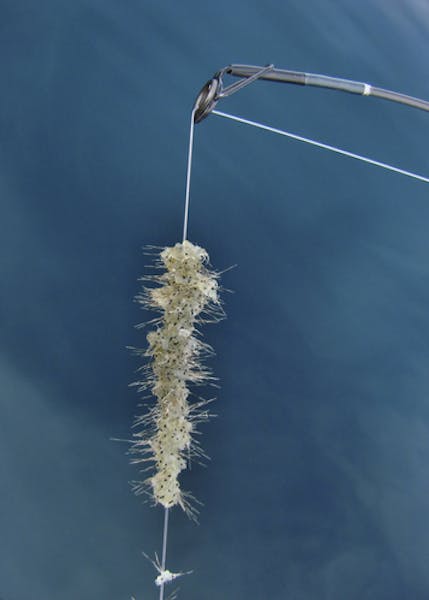Layers of ice, slush and deep snow on lakes north of the Twin Cities could lead to a rash of fish kills this year on shallow lakes susceptible to losses of oxygen, state fisheries managers say.
Especially if the winter drags on without a big thaw, experts for the Department of Natural Resources say this could be the third winter in a row for partial kills of panfish and largemouth bass in vegetated lakes less than 20 feet deep.
Heavy snow cover at midwinter also threatens northwoods deer, Tower area wildlife manager Tom Rusch said this week.
"The snow arrived early this year and the deer are having to slog through it day after day,'' Rusch said. "Unless we get a winter that ends early … they'll start to hit a wall.''
Southern Minnesota contains the greatest abundance of shallow lakes, but conditions south of the Twin Cities — for the time being — are favorable. In Murray County, for example, lake observers are reporting only 4 to 6 inches of snow covering 13 to 20 inches of ice.
"The outlook now is minimal for winter kills,'' said Durel Carstensen of the DNR's New Ulm fisheries office. "We're looking pretty good.''
Shallow, mucky lakes lose dissolved oxygen in a chain reaction that starts when sunlight can't penetrate the water. In the darkness, underwater plants die and decompose. In the process, bacteria use up oxygen needed by fish. Bullheads, carp, perch and northern pike can tolerate the depletion better than other fish, but at about three parts per million of dissolved oxygen, bluegills, crappies and largemouth bass start struggling. Walleyes, too, are vulnerable, but they typically inhabit deeper lakes.
Carstensen said fisheries managers keep a close eye on dissolved oxygen levels across the southern tier of the state because of all the shallow lakes. As of two weeks ago, many of the lakes he tested were "up in the teens'' in terms of parts per million of dissolved oxygen.
Carstensen and Nate Hodgins of the DNR fisheries office in Windom said the good readings haven't stopped anglers in the region from turning on aeration systems in their favorite shallow lakes. Fifty-eight machines are now running in Carstensen's area compared to 79 a year ago at this time.
Doug Kingsley, area fisheries manager for the DNR in Park Rapids, said there's upward of 3 feet of snow and slush covering lakes in his region. Starting in a matter of weeks, crews will be testing oxygen levels on shallow lakes that have produced fish kills in the recent past.
Lakes with the lowest readings will be test-netted in the spring to estimate fish mortality.
"If we find little or none of a species, then we will go and restock it,'' Kingsley said.
In the case of partial fish kills of bass, Kingsley said, his office has achieved restocking success by releasing adult pairs to reproduce on their own.
"That's worked out really well for us,'' he said.
In other cases where there's been a heavy fish kill on a shallow lake, the DNR sometimes will stock walleye fry. Without predation by other species, the baby walleyes can grow relatively quickly.
In the area around Leech Lake, DNR recorded partial fish kills on a few shallow lakes a year ago. Bill Evarts of the DNR's Walker fisheries office said conditions this year could produce a repeat.
"We don't really get too worked up about it,'' Evarts said. "It's not that we're not concerned … but it's a question of, 'What can we reasonably do?' ''
He said restocking has become more complicated in recent years because of precautions that must be taken to avoid introducing fish disease or aquatic invasive species to a lake.
"We used to be able to take care of it quickly by going to a source lake,'' he said.
Still, DNR crews in the Walker area will start testing shallow lakes for oxygen levels toward the end of February, Evarts said. One lake that gets attention is Town Line, southeast of Leech. It has 8 miles of shore but is no deeper than 12 feet. It supports sunfish, crappies, perch, northern pike, largemouth bass and some walleye.
A recent winter fish kill in Town Line prompted Leech Lake Nation to stock the lake with walleye fry. Those fish could grow into keepers if they survive enough winters.
"There's deep snow, slush and not a ton of ice right now,'' Evarts said. "That can all change very fast.''
Whitetail worries
The DNR annually creates a winter severity index map that shades areas of concern for wildlife officials. On a scale from 50 to 180, the current high point on the index map is 77, located along the North Shore. Last year at this time the high score was 99.
"I wouldn't say it's severe quite yet,'' said Barb Keller, the DNR's big game program supervisor. "But it depends on how long this is going to play out.''
Rusch, the wildlife manager from Tower, said this year's deep snowpack in the Arrowhead region could easily last beyond safe limits, especially for fawns. The animals are built to survive about 100 days of such deep snow and an outbreak of colder temperatures could worsen the strain, Rusch said. Then too, wolves will run wild if the fluffy snow crusts over as winter goes on.
"It takes a long time to melt that kind of snowpack in the heavy forest,'' he said.
